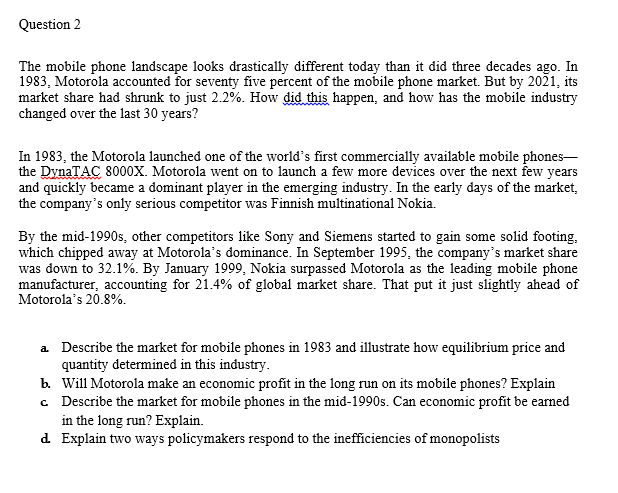Question 2 The mobile phone landscape looks drastically different today than it did three decades ago. In 1983, Motorola accounted for seventy five percent of the mobile phone market. But by 2021, its market share had shrunk to just 2.2%. How did this happen, and how has the mobile industry changed over the last 30 years? In 1983, the Motorola launched one of the world's first commercially available mobile phones- the DynaTAC 8000X. Motorola went on to launch a few more devices over the next few years and quickly became a dominant player in the emerging industry. In the early days of the market, the company's only serious competitor was Finnish multinational Nokia. By the mid-1990s, other competitors like Sony and Siemens started to gain some solid footing, which chipped away at Motorola's dominance. In September 1995, the company's market share was down to 32.1%. By January 1999, Nokia surpassed Motorola as the leading mobile phone manufacturer, accounting for 21.4% of global market share. That put it just slightly ahead of Motorola's 20.8%. a Describe the market for mobile phones in 1983 and illustrate how equilibrium price and quantity determined in this industry. b. Will Motorola make an economic profit in the long run on its mobile phones? Explain c. Describe the market for mobile phones in the mid-1990s. Can economic profit be earned in the long run? Explain. d. Explain two ways policymakers respond to the inefficiencies of monopolists
Question 2 The mobile phone landscape looks drastically different today than it did three decades ago. In 1983, Motorola accounted for seventy five percent of the mobile phone market. But by 2021, its market share had shrunk to just 2.2%. How did this happen, and how has the mobile industry changed over the last 30 years? In 1983, the Motorola launched one of the world's first commercially available mobile phones- the DynaTAC 8000X. Motorola went on to launch a few more devices over the next few years and quickly became a dominant player in the emerging industry. In the early days of the market, the company's only serious competitor was Finnish multinational Nokia. By the mid-1990s, other competitors like Sony and Siemens started to gain some solid footing, which chipped away at Motorola's dominance. In September 1995, the company's market share was down to 32.1%. By January 1999, Nokia surpassed Motorola as the leading mobile phone manufacturer, accounting for 21.4% of global market share. That put it just slightly ahead of Motorola's 20.8%. a Describe the market for mobile phones in 1983 and illustrate how equilibrium price and quantity determined in this industry. b. Will Motorola make an economic profit in the long run on its mobile phones? Explain c. Describe the market for mobile phones in the mid-1990s. Can economic profit be earned in the long run? Explain. d. Explain two ways policymakers respond to the inefficiencies of monopolists
Principles of Microeconomics
7th Edition
ISBN:9781305156050
Author:N. Gregory Mankiw
Publisher:N. Gregory Mankiw
Chapter17: Oligopoly
Section: Chapter Questions
Problem 9PA
Related questions
Question

Transcribed Image Text:Question 2
The mobile phone landscape looks drastically different today than it did three decades ago. In
1983, Motorola accounted for seventy five percent of the mobile phone market. But by 2021, its
market share had shrunk to just 2.2%. How did this happen, and how has the mobile industry
changed over the last 30 years?
In 1983, the Motorola launched one of the world's first commercially available mobile phones-
the DynaTAC 8000X. Motorola went on to launch a few more devices over the next few years
and quickly became a dominant player in the emerging industry. In the early days of the market,
the company's only serious competitor was Finnish multinational Nokia.
By the mid-1990s, other competitors like Sony and Siemens started to gain some solid footing,
which chipped away at Motorola's dominance. In September 1995, the company's market share
was down to 32.1%. By January 1999, Nokia surpassed Motorola as the leading mobile phone
manufacturer, accounting for 21.4% of global market share. That put it just slightly ahead of
Motorola's 20.8%.
a Describe the market for mobile phones in 1983 and illustrate how equilibrium price and
quantity determined in this industry.
b. Will Motorola make an economic profit in the long run on its mobile phones? Explain
c. Describe the market for mobile phones in the mid-1990s. Can economic profit be earned
in the long run? Explain.
d.
Explain two ways policymakers respond to the inefficiencies of monopolists
Expert Solution
This question has been solved!
Explore an expertly crafted, step-by-step solution for a thorough understanding of key concepts.
Step by step
Solved in 3 steps with 1 images

Knowledge Booster
Learn more about
Need a deep-dive on the concept behind this application? Look no further. Learn more about this topic, economics and related others by exploring similar questions and additional content below.Recommended textbooks for you

Principles of Microeconomics
Economics
ISBN:
9781305156050
Author:
N. Gregory Mankiw
Publisher:
Cengage Learning


Managerial Economics: A Problem Solving Approach
Economics
ISBN:
9781337106665
Author:
Luke M. Froeb, Brian T. McCann, Michael R. Ward, Mike Shor
Publisher:
Cengage Learning

Principles of Microeconomics
Economics
ISBN:
9781305156050
Author:
N. Gregory Mankiw
Publisher:
Cengage Learning


Managerial Economics: A Problem Solving Approach
Economics
ISBN:
9781337106665
Author:
Luke M. Froeb, Brian T. McCann, Michael R. Ward, Mike Shor
Publisher:
Cengage Learning

Microeconomics: Principles & Policy
Economics
ISBN:
9781337794992
Author:
William J. Baumol, Alan S. Blinder, John L. Solow
Publisher:
Cengage Learning

Managerial Economics: Applications, Strategies an…
Economics
ISBN:
9781305506381
Author:
James R. McGuigan, R. Charles Moyer, Frederick H.deB. Harris
Publisher:
Cengage Learning